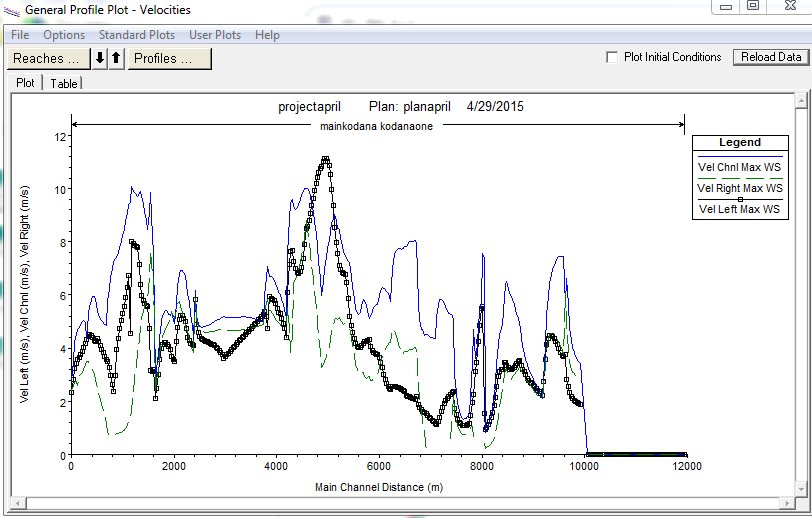Welcome to the RAS Solution › Forums › HEC-RAS Help › Dam Break
- This topic has 16 replies, 1,591 voices, and was last updated 11 years, 1 month ago by Labonia.
-
AuthorPosts
-
November 14, 2014 at 6:58 pm #5630LaboniaParticipant
Hi,
I have a problem in the simulation of Dam Break in Hec Ras on the sudden collapse of the dam. How should I do?
RegardsNovember 14, 2014 at 8:33 pm #8989AnonymousGuestWhat is the problem that you are having? Is it a numerical stability issue or a question of how to use RAS for the scenario that you are interested in? A bit more info. would be useful.
November 17, 2014 at 7:28 pm #8990LaboniaParticipantMy problem consists in the procedure to be used for the collapse of Ras improvviso.Ho has tried to simulate the sudden collapse , after entering the various geometric data with a linear type :
Time Fraction Fraction Breach
0 1
0.5 1
1 1
using this expression invaded upstream does not empty .
I would like to know if the procedure I used is correct or there is another procedure to be applied .I would be grateful for the resolution of the problem.November 18, 2014 at 3:22 pm #8991LaboniaParticipantHi,
I could use a tutorial of Dam Break explaining in detail all the steps to do and an example to solve my problem .
Where can I find it?November 18, 2014 at 5:28 pm #8992AnonymousGuestThe HEC publication TD-39 “Using HEC-RAS for Dam Breach Studies” is a thorough document on this subject. It can be found at: http://www.hec.usace.army.mil/publications/TrainingDocuments/TD-39.pdf
November 20, 2014 at 1:27 pm #8993LaboniaParticipantHi,
publication in the TD- 39 is not mentioned the procedure to be carried out by the sudden collapse of a gravity dam for which the publication was not helpful to the resolution of my problem .The would be grateful for more information .November 20, 2014 at 8:05 pm #8994AnonymousGuestThe algorithm in HEC-RAS for computation of a dam failure outflow hydrograph does not include an instantaneous failure. In HEC-RAS, the failure time is finite. So, the time for the development of the breach and subsequent, computed, breach outflow hydrograph are done within several computational time steps. Should you wish to model a situation with an instantaneous breach, you might want to develop the breach outflow hydrograph external to RAS and input it as an upstream flow hydrograph. Perhaps you will find HEC document RD-8 “Dimensionless Graphs of Floods From Ruptured Dams” useful.
November 26, 2014 at 2:45 am #8995RobertParticipantGood day,
You have a right, that a concrete dam failure is suddendly (Qmax=0h:0m)
I was solving concrete dam break using method level-pool routing, because I had a limited input data (volume curve) for reservoir. (I couldn’t use dynamic routing method)
After, you have to determine a breach characteristic (location, shape and size) in the concrete dams.
Example:
Location- near a functional object (weir gate)
shape and size- the entire block as the foundation/base/groundSome printscreen from my project (see links)
https://drive.google.com/file/d/0B6wWUzbPUM0dMERpV2tvNDhTRDA/view?usp=sharing
https://drive.google.com/file/d/0B6wWUzbPUM0dZWxOV0dpT0ZSVUE/view?usp=sharing
https://drive.google.com/file/d/0B6wWUzbPUM0dT3RudGcwN2dPSEk/view?usp=sharingRegards!
RobertMarch 20, 2015 at 4:20 pm #8996sotirisParticipantHello everyone,
I am trying to simulate a dam break due to piping but I do not know if there are regression models for this type of failure, apart from Froehlich 1995 and 2008. Could someone give me some hints? Thanks in advanceMarch 27, 2015 at 12:54 am #8997RobertParticipantHi
This is difficult question for:
large or small dam
earth dam or rockfill damI think, you should use all equations for breach parameters estimations. Then you can/should compare your results (parameters of dam, width of breach, failure of breach) with database of failure dams (Bureau of reclamation- 108 case of dams failure).
By the way: i would choose a Froehlich 2008 🙂
regards!
robertMarch 31, 2015 at 9:45 am #8998AnonymousGuestHi! Robert is it possible to share the steps or some sort of tutorial to model the Dam break analysis? Because I also want to do the same thing in Hecras.
April 1, 2015 at 12:42 am #8999RobertParticipantHi
I recognize you these documents:
1. Create of model by HEC-RAS
https://drive.google.com/file/d/0B6wWUzbPUM0dNmo3RnViUDJwR28/view?usp=sharing2. Estimating of breach parameters and Downstream flood-wave routing
https://drive.google.com/file/d/0B6wWUzbPUM0delV2ZmFlTTB1Q0k/view?usp=sharingI hope, that I help you. In case of uncertainty, you can write me!
have a nice day
RobertApril 29, 2015 at 3:06 pm #9000emtithalParticipantApril 29, 2015 at 10:48 pm #9001AnonymousGuestThese channel velocities might be valid. Assuming that the RAS run converged OK and it’s a subcritical reach. The reproduction of the Teton Dam failure with RAS shows channel velocities in the range of 4 to >7 m/sec.
April 30, 2015 at 11:29 am #9002emtithalParticipantThanks for your advice
But my teacher lell me” the values of velicity not logical”
Ican’t calibration for reach because I don’t have data so, I assum value Manning’s between (0.035 – 0.06) because the ground surface very hard , also the water during the break walk quikly
I will try uplowde my project for help me
Again Thanks -
AuthorPosts
- You must be logged in to reply to this topic.
